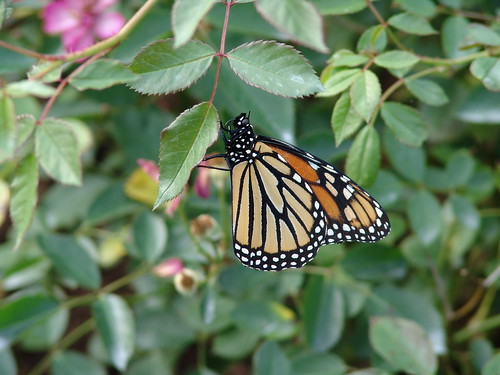Tip of the Week: Favorite Plants for Butterflies, Caterpillars
Posted in Gardening Tips on July 26 2010, by Sonia Uyterhoeven
 |
Sonia Uyterhoeven is Gardener for Public Education. Join her each weekend for home gardening demonstrations on a variety of topics in the Home Gardening Center. July 31 and August 1 she will present Butterfly Bonanza. |
 Last week I talked about the life cycle of butterflies and how you can create a garden with features important to caterpillars as well as adult butterflies. Today we’ll look at some of the plants that both prefer.
Last week I talked about the life cycle of butterflies and how you can create a garden with features important to caterpillars as well as adult butterflies. Today we’ll look at some of the plants that both prefer.
When designing a butterfly garden, first find out the kinds of butterflies you can expect to see in your area so that you’ll know what you need to attract them into your garden. Shop in the Garden and the LuEsther T. Mertz Library have a wonderful collection of books on the subject.
Some of the common butterflies you will find in the New York area are the spicebush swallowtail, black swallowtail, eastern tiger swallowtail, monarch, viceroy, clouded sulphur, buckeye, spring azure, and pearl crescent.
Good nectar sources for regional butterflies are lilacs (Syringa), clover (Trifolium), chives (Allium), cosmos (Cosmos), zinnias (Zinnia), lavender (Lavandula), catmint (Nepeta), milkweed (Asclepias), mint (Mentha), bee balm (Monarda), blazing star (Liatris), phlox (Phlox), anise hyssop (Agastache), bugbane (Cimicifuga), butterfly bush (Buddleja), summersweet (Clethra), blue mist shrub (Caryopteris), and glossy abelia (Abelia).
You’ll also need to include host plants for the hungry caterpillars such as fennel (Foeniculum), parsley (Petroselinum), rue (Ruta), violets (Viola), turtlehead (Chelone), asters (Aster), spicebush (Lindera), blueberry bush (Vaccinium), viburnums (Viburnum), willows (Salix), dogwoods (Cornus), cherries (Prunus), and maples (Acer).
When designing a butterfly garden, plant annuals and perennials in large drifts. If they are host plants, you will hardly notice the nibbled leaves of the feeding caterpillars; if they are nectar plants, then you will have created a highly visible feeding site. If you give the butterflies plenty to eat, they will stay longer. Also, diversity attracts diversity. An interesting and varied landscape will be attractive to other wildlife as well.
Deadheading your plants will prolong bloom, and cutting back asters and chrysanthemums (Chrysanthemum) by half early in the season will produce fuller plants. In the Home Gardening Center, monarchs cover these late season perennials for a final feed before they make their long migratory journey to Mexico.
Capitalize on all the sunny spots in your yard. If your garden is shady but you have a sunny patio, plant containers full of annuals and perennials. Don’t excessively manicure your yard. Leaf litter, tall grass, and peeling bark provide butterflies ideal places to spend the night or to overwinter.
It is important to include both herbaceous and woody material in your butterfly garden. Trees and shrubs not only provide butterflies with food but also offer protected areas from the wind and predators. Finally, remember to plan for a sequence of blooms, staggering the flowering time of nectar sources so that butterflies will frequent your garden throughout the season.
For more information on butterfly gardening, come to my Home Gardening Demonstration Butterfly Bonanza on July 31 and August 1 at 2 p.m. in the Home Gardening Center.

